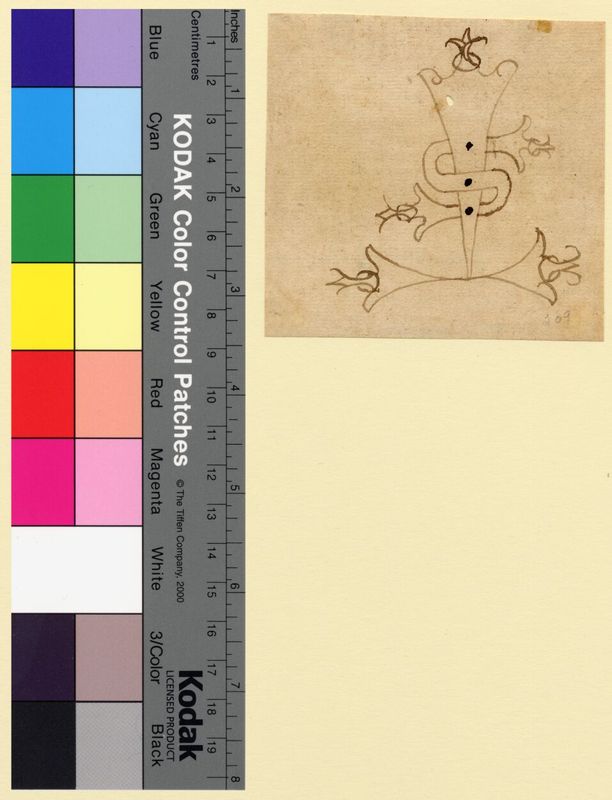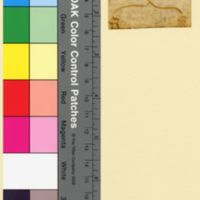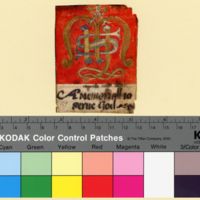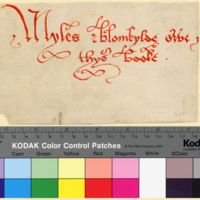Fragmenta Manuscripta
Monograms, Stamps, Ownership Marks, and Doodles
Monograms
In addition to decoration, there were other marks found on manuscripts including marks of ownership. A monogram is a motif that often combines the initials in a person’s name with other symbols. In ancient and medieval societies, monograms functioned like our signatures. Notaries often made use of monograms, and in the medieval west, the choice to use a monogram was informed by geographic localities. For instance, notaries in southern and eastern France, Spain, and Italy preferred to sign their documents with unique monograms. While areas in northern and western France, England, Scotland, Wales, and Ireland preferred to attach seals to signify their authority and authorship of documents. The signature became the more common ownership mark on documents beginning in the fourteenth century, although monograms and seals continued to be used.[1]
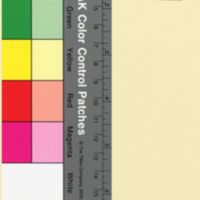
Identifier: Fragmenta Manuscripta 203
Contents: Library stamp (partial)
Language: Latin
Location: ?
Script: Humanistic
Stamps and Ownership Marks
Stamps and notes also display ownership. Fragmenta Manuscripta has an example of a library stamp (FM 203), a sixteenth-century ownership note in English identifying a Myles Blomfylde who owned “thys booke” (FM 202), and another sixteenth century note—this time in Latin—identifying the owner as one Johanne Neuton (FM 200). The Neuton note does not follow the rules of the Latin language. It says “Johanne Neuton “hunc librum pertinent.” Hunc means “this,” librum means “book,” and pertinent comes from the verb pertinēre meaning to own, however, it is conjugated incorrectly. The form pertinent uses the third person plural form of the verb, meaning “they own.” The verb should have been conjugated pertineō, which is the first-person singular form of the verb and would make the sentence read “Johanne Neuton owns this book.” The incorrect use of Latin on this sixteenth-century manuscript leaf is indicative of the decline of Latin after the vernacular languages were used increasingly for official documents from the fourteenth century on.

Identifier: Fragmenta Manuscripta 199
Date: 1500-1599
Contents: Pen trials
Location: England
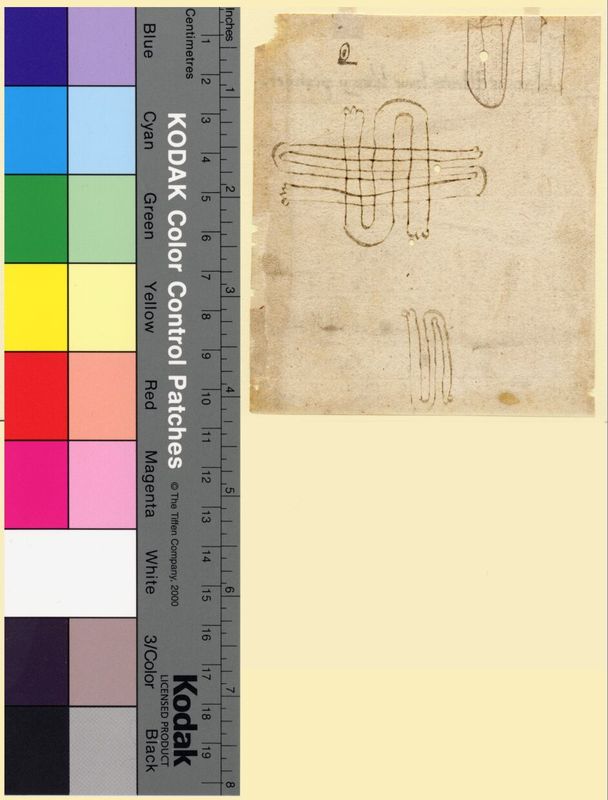
Identifier: Fragmenta Manuscripta 200
Date: 1500-1599
Contents: Ownership note
Language: Latin
Location: England
Doodles
Doodles are another type of mark found on the leaves in the collection. It took a practiced hand to write the uniform text on the pages of manuscripts. One fragment in the collection shows us how scribes would practice their letter forms and test the ink on their writing implements before writing out the text. FM 199 has a number of these “pen trials” that include the opening words used in a variety of legal documents “Sciant presentes…” meaning “know those present.”[2]
Another doodle is on the verso of FM 200. The doodle comprises one horizontal curvilinear shape with scalloped edges at the two ends overlapping an identical vertical shape. This pattern resembles a Solomon’s knot, which is a kind of interlace pattern that has four overlapping points. The Solomon’s Knot is meant to have no beginning and no end and therefore was symbolic of eternity in certain cultures. The Fragmenta Manuscripta example is not a true Solomon’s Knot since the ends of the doodle do not connect to one another. Perhaps the doodler was designing an interesting kind of interlace pattern, or they were mindlessly doodling while their teacher instructed them, or perhaps this was meant to be some kind of monogram or notarial mark. We may never know the purpose of the mark, if there was one, but it—and other marks like it—breathe life and personality into the collection of manuscript fragments.
NOTES
[1] Brigitte Bedos-Rezak, “Women, Seals, and Power in Medieval France, 1150-1350,” in Women and Power in the Middle Ages, edited by Mary Carpenter Erler and Maryanne Kowaleski (Athens: University of Georgia Press, 1988), 64-65.
[2] For more on legal texts in the collection see “charters and deeds” under Secular Law.
